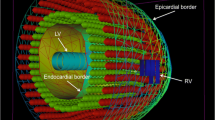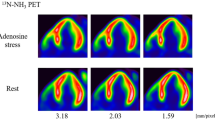Abstract
Quantification of myocardial flow reserve (MFR) provides diagnostic value for detection of cardiovascular artery disease. However, the common calculation method for MFR requires dynamic acquisition and specific software. The study aimed to predict coronary artery disease by simpler calculation of myocardial count without the use of dynamic data from 13N-ammonia myocardial perfusion positron emission tomography (MP-PET). This study included 40 consecutive patients suspected of ischemic heart disease and 7 healthy controls (34 men and 13 women, 66 ± 12 years). All participants underwent adenosine stress and rest 13N-ammonia MP-PET. From the dynamic images, the MFR in the entire left ventricular myocardium (ELV) and the three-vessel area was calculated by dividing stress myocardial blood flow (MBF) by rest MBF. From the static images, the myocardium-to-background ratio (MBR) was calculated by dividing each area’s counts/pixel by background counts in the upper thoracic aorta/pixel in both stress and rest images. The MBR-increasing rate (MBR-IR) was calculated by dividing stress MBR by rest MBR. The relationship between MFR and MBR-IR in each area was examined. The cutoff diagnostic value of MBR-IR corresponding to that of MFR for detection of cardiovascular artery disease was calculated. Each MBR-IR was closely correlated with each MFR (r = 0.830 in ELV, r = 0.864 in LAD, r = 0.829 in LCX, r = 0.757 in RCA). The cutoff values of MBR-IR were 1.45 in ELV, 1.46 in LAD, 1.41 in LCX, and 1.45 in RCA, respectively. This study demonstrated that quantification of MBR-IR may provide diagnostic value for detection of coronary artery disease as well as MFR.



Similar content being viewed by others
References
Ter-Pogossian MM, Phelps ME, Hoffman EJ, Mullani NA (1975) Apositron-emission transaxial tomograph for nuclear imaging (PETT). Radiology 114:89–98
Schelbert HR, Phelps ME, Hoffman E, Huang SC, Kuhl DE (1980) Regional myocardial blood flow, metabolism and function assessed noninvasively with positron emission tomography. Am J Cardiol 46:1269–1277
Gaemperli O, Bengel FM, Kaufmann PA (2011) Cardiac hybrid imaging. Eur Heart J 32:2100–2108
Ghosh N, Rimoldi OE, Beanlands RS, Camici PG (2010) Assessment of myocardial ischaemia and viability: role of positron emission tomography. Eur Heart J 31:2984–2995
Fiechter M, Ghadri JR, Gebhard C et al (2012) Diagnosticvalue of 13N-ammonia myocardial perfusion PET: added value of myocardial flow reserve. J Nucl Med 53:1230–1234
Herzog BA, Husmann L, Valenta I et al (2009) Long-term prognostic value of 13N-ammonia myocardial perfusion positron emission tomography added value of coronary flow reserve. J Am Coll Cardiol 54:150–156
van de Hoef TP, van Lavieren MA, Damman P et al (2014) Physiological basis and long-term clinical outcome of discordance between fractional flow reserve and coronary flow velocity reserve in coronary stenoses of intermediate severity. Circ Cardiovasc Interv 7:301–311
Yokoyama I, Ohtake T, Momomura S, Nishikawa J, Sasaki Y, Omata M (1996) Reduced coronary flow reserve in hypercholesterolemic patients without overt coronary stenosis. Circulation 94:3232–3238
Hutchins GD, Schwaiger M, Rosenspire KC, Krivokapich J, Schelbert H, Kuhl DE (1990) Noninvasive quantification of regional blood flow in the human heart using N-13 ammonia and dynamic positron emission tomographic imaging. J Am Coll Cardiol 15:1032–1042
Kaufmann PA, Gnecchi-Ruscone T, Yap JT, Rimoldi O, Camici PG (1999) Assessment of the reproducibility of baseline and hyperemic myocardial blood flow measurements with oxygen-15 labeled water and PET. J Nucl Med 40:1848–1856
Tomiyama T, Ishihara K, Suda M et al (2015) Impact of time-of-flight on qualitative and quantitative analyses of myocardial perfusion PET studies using 13N-ammonia. J Nucl Cardiol 22:998–1007
Tomiyama T, Kumita S, Ishihara K et al (2015) Patients with reduced heart rate response to adenosine infusion have low myocardial flow reserve in 13N-ammonia PET studies. Int J Cardiovasc Imaging 31:1089–1095
Taki J, Fujino S, Nakajima K et al (2001) (99 m) Tc-sestamibi retention characteristics during pharmacologic hyperemia in human myocardium: comparison with coronary flow reserve measured by Doppler flowire. J Nucl Med 42:1457–1463
Fukushima Y, Kumita S, Tokita Y, Sato N (2016) Prognostic value of myocardial perfusion SPECT after intravenous bolus administration of Nicorandil in patients with acute ischemic heart failure. J Nucl Med 57:385–391
Surti S, Kuhn A, Werner ME, Perkins AE, Kolthammer J, Karp JS (2007) Performance of Philips Gemini TF PET/CT scanner with special consideration for its time-of-flight imaging capabilities. J Nucl Med 48:471–480
DeGrado TR, Hanson MW, Turkington TG et al (1996) Estimation of myocardial blood flow for longitudinal studies with 13N-labeled ammonia and positron emission tomography. J Nucl Cardiol 3:494–507
Schelbert HR, Phelps ME, Huang SC et al (1981) N-13 ammonia as an indicator of myocardial blood flow. Circulation 63:1259–1272
Loghin C, Sdringola S, Gould KL (2004) Common artifacts in PET myocardial perfusion images due to attenuation-emission misregistration: clinical significance, causes, and solutions. J Nucl Med 45:1029–1039
Schwaiger M, Ziegler S, Nekolla SG (2005) PET/CT: challenge for nuclear cardiology. J Nucl Med 46:1664–1678
Alessio AM, Kohlmyer S, Branch K, Chen G, Caldwell J, Kinahan P (2007) Cine CT for attenuation correction in cardiac PET/CT. J Nucl Med 48:794–801
Acknowledgements
We gratefully acknowledge Keiichi Ishihara, MD, PhD, for his helpful discussion and advice. We are also grateful to the radiology technologists Masaya Suda, Koji Kanaya, and Minoru Sakurai for their technical assistance in conducting 13N-ammonia MP-PET.
Author information
Authors and Affiliations
Corresponding author
Ethics declarations
Conflict of interest
The authors have no conflict of interest to declare.
Ethical approval
The institutional review board approved this retrospective study and the requirement to obtain informed consent was waived (28-10-655). This study was performed in accordance with the ethical standards of the Declaration of Helsinki.
Rights and permissions
About this article
Cite this article
Hashimoto, H., Fukushima, Y., Kumita, Si. et al. Feasibility of myocardial flow reserve prediction without the use of dynamic data from myocardial perfusion positron emission tomography. Int J Cardiovasc Imaging 34, 1323–1329 (2018). https://doi.org/10.1007/s10554-018-1335-z
Received:
Accepted:
Published:
Issue Date:
DOI: https://doi.org/10.1007/s10554-018-1335-z




